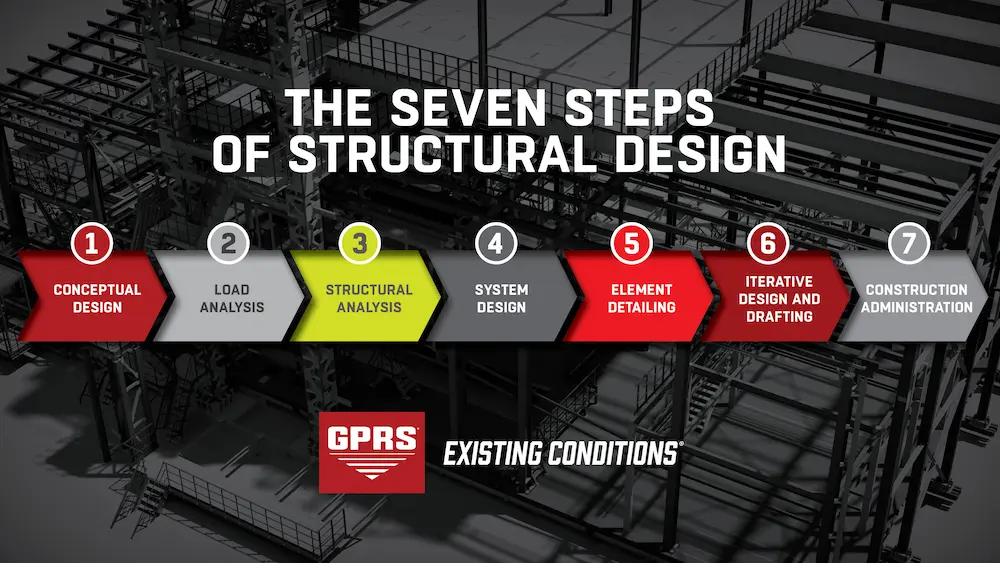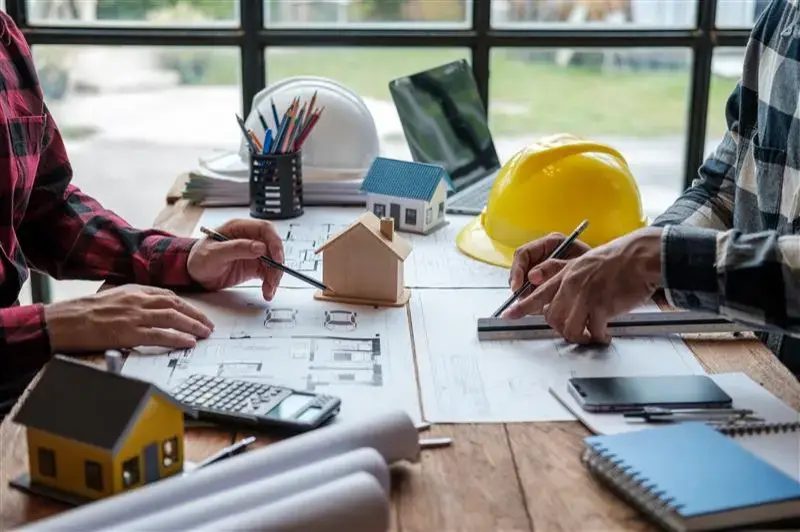What is the Step-by-Step Process of Structural Design?

Structural design is the backbone of any construction project. It ensures that buildings are safe, functional, and capable of withstanding anticipated loads. The process encompasses engineering principles, material science, and regulatory compliance. This guide covers each phase of structural design. It highlights how accurate as-built drawings and BIM models guide decisions from concept to construction.
Step 1: Conceptual Design
The design process starts with conceptual planning. Here, we check if the idea is doable and turn the architectural vision into a structural form. Collaboration between architects and engineers is key. It helps match spatial needs with structural feasibility. At this stage, conditions on the site are important. Soil type and environmental factors play a crucial role.
These factors play a key role in decision-making. They help decide if shallow or deep foundations are suitable. They also guide the choice of materials, like steel, concrete, or timber.
Budgetary constraints balance performance and safety. Preliminary layouts include:
- Column grids
- Beam spans
- Slab configurations
These serve as the basis for further analysis.
Ignoring site conditions early can lead to costly redesigns later. For example, failure to account for weak soil layers may lead to settlement issues. This can compromise structural integrity.
Step 2: Load Analysis
Once engineers establish the conceptual framework, they perform load analysis. This is to quantify the forces the structure will face. This includes dead loads, live loads, and environmental forces. These forces are wind, earthquakes, and snow.
According to Panel Built Incorporated, “A dead load refers to a structure's static, non-moving weight or any permanent components that form an integral part of it.”
Standards like ASCE 7-22 provide methods for calculating load combinations and worst-case scenarios. This helps protect against structural failure.
Step 3: Structural Analysis
Structural analysis evaluates how the building will respond to the identified loads.

Universidad Europea states that “Whether it's designing skyscrapers, bridges, or even residential homes, structural analysis plays a crucial role in ensuring the safety, stability, and durability of structures.”
Engineers can also utilize Building Information Modeling for structural analysis. “Structural analytical modeling in Revit enables engineers to coordinate between physical and analytical models and facilitates BIM-centric analysis workflows.” – Autodesk
Existing conditions documentation is created using 3D laser scans. This method ensures high accuracy for construction. It can also reveal potential weaknesses before construction starts.
Step 4: System Design
Following the analysis, engineers select the structural system. This includes frames, trusses, and shear walls.
According to Designhub1610, “Choosing the right structure system is a foundational decision that shapes a building’s design, function, and overall stability.”
.webp)
Different buildings need different types of support. For example, a hospital might need a strong frame that can handle earthquakes. A warehouse might use a simpler frame to be cost-efficient.
When choosing a structure, engineers consider several factors:
- The building's purpose
- Its location
- The weight it needs to hold
- The budget available
- The architectural design
Step 5: Element Detailing
Detailing converts conceptual plans into construction-ready documents. Engineers specify dimensions, reinforcement, and connection details for structural elements.
Compliance with material-specific standards ensures safety and longevity. For example, improper detailing of beam-column joints can cause brittle failures during earthquakes. Attention to detail at this stage is crucial.
Step 6: Iterative Design and Drafting
Design refinement is an iterative process. Engineers revise layouts based on analysis results, stakeholder feedback, and coordination meetings.
“The whole process is iterative, meaning that engineers repeat the steps as many times as needed, making improvements along the way as they learn from ‘failure,’ which can aptly be seen as opportunity,” says Engineers Canada.
Digital tools like BIM streamline this process. It allows for real-time updates and clash detection. Accurate existing conditions data is essential for resolving conflicts. An example is a structural beam crossing HVAC ductwork. It's best to resolve these issues before construction starts.
Designing a building takes many tries. Engineers change their plans as new information comes in. This helps them follow safety rules, use materials better, and improve building performance. They refine the design through ongoing adjustments until it’s safe, useful, affordable, and feasible to build.
Step 7: Construction Administration
During construction, the Engineer of Record (EOR) ensures compliance with design specifications. Responsibilities include:
- Reviewing RFIs
- Approving deferred submittals
- Conducting site inspections
Timely verification of existing conditions is critical. If engineers don’t visit the site on time, the building might be built differently than planned, which can affect safety.
What is the Role of Existing Conditions in Structural Design?
Existing Conditions offers precise reality capture services. This helps project teams get accurate site data. With this information, they can make informed decisions right from the start of design and construction.
By leveraging Existing Conditions’ advanced reality capture services early in the design and construction process, project teams gain access to precise site data that reduces risk, improves coordination, and ensures alignment between design intent and actual field conditions.
Structural design is a precise process. It needs accurate information at all stages, starting from planning to construction oversight. Existing Conditions offers high-resolution scans and quality BIM models. These tools help engineers, architects, and contractors make informed choices. They can also identify clashes early and prevent costly change orders. Partnering with a trusted provider like Existing Conditions means teams have reliable data from day one.
Over the past 27 years, Existing Conditions has measured, documented, and modeled over 10,000 buildings spanning over 700 million square feet across the United States, establishing ourselves as an industry leader in reality capture. Architects, builders, engineers, developers, and facility managers trust us to deliver digital representations of the as-built environment with unparalleled accuracy and efficiency. Our services, including 3D laser scanning, 3D photogrammetry, and BIM modeling, Visualize The Built World® to enable architects to make informed design decisions based on the most accurate data available.
What can we help you visualize?
Frequently Asked Questions
How does Existing Conditions support the conceptual design phase?
Existing Conditions’ Project Managers utilizes 3D laser scanning and photogrammetry to capture site details with millimeter-level precision. This accurate data allows architects and engineers to visualize terrain, current structures, and environmental constraints. By understanding the site early on, teams can make informed choices about foundation types, structural frameworks, and material selection during the initial design phase.
What role does reality capture play in load analysis?
Reality capture produces high-resolution point clouds and BIM models that simulate how forces interact with the structure. These models integrate with structural analysis tools like Revit. This enables engineers to assess stress, stability, and durability under various load scenarios. This process also helps identify potential weaknesses before construction begins, improving safety and efficiency.









